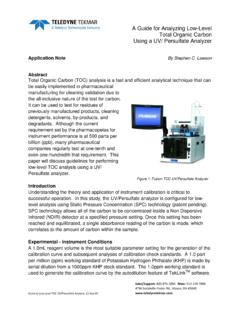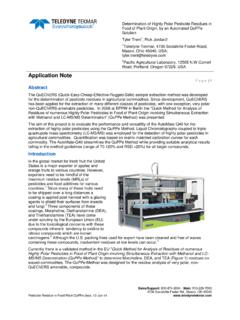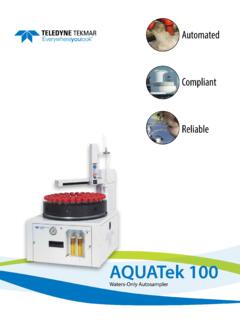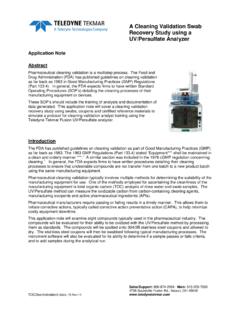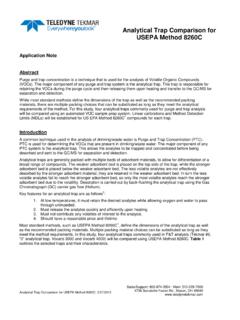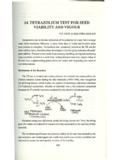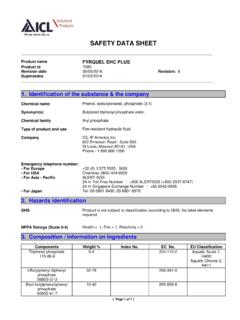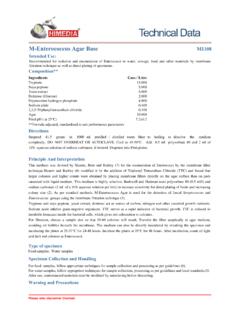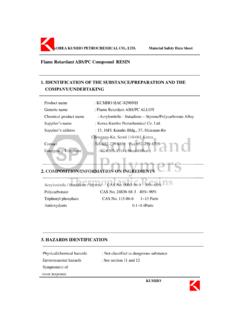Transcription of Pesticide Analysis Using QuEChERS Extraction: A …
1 Pesticide Analysis Using QuEChERS extraction : A comparison of manual and Automated Approaches 1 4736 Socialville Foster Rd Mason, OH 45040 USA Abstract QuEChERS is a Quick-Easy-Cheap-Effective-Rugged-Safe extraction method that has been developed for the determination of Pesticide residues in agricultural commodities. QuEChERS itself has evolved from the original unbuffered method to a pair of multi-laboratory validated methods Using citrate buffering (EN 15662:2008) or acetate buffering (AOAC Official Method ). While originally developed for plant matrices, the technique has since been adapted to be used in several applications and in many additional matrices.
2 The rise in popularity of the technique and the increase in sample testing loads have lead to automation as a possible solution to increase productivity. The method, as mentioned, is a simple and fast extraction when compared to traditional semi-volatile extraction techniques. However, it still requires dedicated manpower, extraction equipment, manual spiking, manual pipetting, and a wide range of reagents and consumables. The analytical and practical challenges of automating this technique will be discussed and a comparison of extraction recoveries achieved both manually and by automation will be evaluated.
3 Data will be presented that justifies automation as a possible solution to increase sample throughput, reduce costs, and improve the accuracy and precision of the extraction . Introduction Increasing globalization of the food industry has lead to increased concerns about food safety. This has resulted in an increased number of pesticides residues which must be regulated and monitored by governing bodies. The QuEChERS method was published in 2003 for the extraction of Pesticide residues in agricultural Modifications to the method have expanded the scope to include many additional matrices and target analytes.
4 After validation, the methods were adopted as AOAC Official Method , and EN 15662 These methods require several manual steps, such as addition of extraction solvent, salts/buffer addition, spiking, shaking, mixing, centrifugation, transferring to a dispersive solid phase extraction (dSPE) step, and finally measuring and transferring a portion of the With the increasing amounts of samples required to be analyzed for Pesticide residues, Teledyne Tekmar has developed the AutoMate-Q40. This revolutionary system is designed and optimized to automate the QuEChERS sample extraction workflow.
5 The AutoMate-Q40 is configured to perform two of the most popular QuEChERS extraction methods. This poster will compare results from both the AutoMate-Q40 and manual QuEChERS extractions Using the AOAC Method 2 4736 Socialville Foster Rd Mason, OH 45040 USA Experimental-Instrument Conditions Analyses were performed on a Thermo Trace Ultra GC equipped with an ISQ mass spectrometer. Instrument conditions can be seen below in Tables 1 and 2. The QuEChERS extractions were performed by the AutoMate-Q40 and manually by an analyst.
6 Figure 1 shows the flow chart the AutoMate-Q40 followed for the AOAC sample extraction procedure. GC Conditions Thermo Trace Ultra GC Column Restek 5MS-Sil m x mm x m Column Constant Flow mL/min Oven Program C,( min), 25 C/min to 150 C, ( min), C/min to 250 C ( min), C/min to C ( min) S/SL Temperature 250 C S/SL Mode Splitless with Surge Pressure Split Flow 50 mL/min Transfer Line Temperature 290 C Table 1: Thermo Trace Ultra GC conditions Analyte SIM RT (min) Trifluralin , Atrazine , Chlorothalonil , Chloropyrophos-methyl , Cyprodinil , Procymidone , 2,4 -DDD , Kresoxim-methyl , Triphenyl Phosphate (TPP) , Bifenthrin , Lambda-Cyhalothrin , Cis-Permethrin , Trans-Permethrin , Table 2: Thermo ISQ acquisition parameters used for the Analysis of pesticides by GC/MS 3 4736 Socialville Foster Rd Mason, OH 45040 USA Sample Preparation A.
7 Sampling Six pounds of apples were purchased from a local grocery store in Mason, Ohio. All six pounds were chopped into small cubes as prescribed in the method. The whole apple was used but the seeds were discarded. The chopped apple cubes were then placed into a plastic bag and frozen overnight. On the day of Analysis the required amount of sample was removed and then carefully extraction /Cleanup For the extraction , a 15 g (+ g) homogenized apple sample was placed into a 50 mL centrifuge tube. The AutoMate-Q40 then moved the centrifuge tubes to a de-capping station where the caps were removed.
8 Using a dual pump liquid handling system, the instrument was programmed to add extraction solvent and spiking solutions to the samples. 15 mL of 1%HAc in ACN and 75 Ls of internal standard (20 g/mL) were added to each sample to yield a 100 ng/g concentration. QC samples were fortified with 50 uL and 250 L of the QC spiking solution (6 g/mL), yielding 20 ng/g and 100 ng/g check samples. g of AOAC extraction salts were added by the solids dispenser. The samples were automatically capped and moved to the shaker where they were shaken vigorously for 1 minute to ensure complete mixing.
9 Once the mixing was complete the samples were centrifuged for 5 minutes at 4000 rpm. Upon completion, the centrifuged samples were transferred to the VialVision (patent pending) station. Once there, a camera determines the positions of the layers in the vial and calculates the available supernatant that can be transferred to a dSPE cleanup vial. The samples are then transferred from the VialVison station to a pipetting station where the necessary 15 mL dSPE cleanup tube waits. The centrifuge tubes are uncapped, and Using the air displacement pipetter (ADP), an 8 mL aliquot is transferred from the extraction tube to the 15 mL dSPE tube containing 400 mg of PSA and 1200 mg of returned to the tray while the 15 mL dSPE tube is moved to the shaker and shaken for 1 minute.
10 Once the mixing is complete the sample is then moved to the centrifuge and spun for 5 minutes at 4000 rpm. Once centrifuging is complete, the 15 mL dSPE cleanup tube is moved to the VialVision station to determine the amount of extract available to be transferred to the final extract tube. The 15 mL dSPE cleanup tube is moved from the VialVison station to a shuttle where the corresponding 15 mL final extract tube waits. The cleanup and final extract tubes are uncapped and, Using the ADP 5 mL of the final extract is transferred to the final tube.
